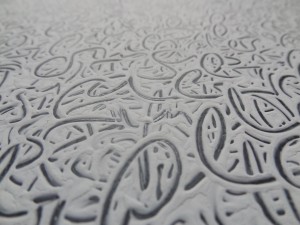dal 27 febbraio al 22 marzo 2019
A cura di Francesca Gallo
Le opere raccolte nella prima personale romana di Sabine Müller-Funk, Nel mare dei segni, sono lavori recenti accomunati da una fitta trama di segni grafici, che paiono essersi depositati su supporti diversi: dal vetro alla plastica stampata. Un vera babele, in cui verbale e visivo si fondono e si intrecciano, a partire dalla comune radice segnica, proprio come in Cy Twombly, il pittore amato da Sabine Müller-Funk.
Se Twombly era stato affascinato dalla sedimentazione di graffiti e incisioni sui muri di Roma, palinsesti di secolari passaggi giunti fino a noi come relitti del tempo, Sabine è invece immersa nella semiosfera contemporanea, in cui schermi di diversa natura popolano lo spazio quotidiano. Proprio agli schermi, infatti, fanno riferimento sia gli oggetti in vetro – lavorati in modo da annullare quasi del tutto la trasparenza e farsi supporto opaco che accoglie lo sfrangiarsi della grafia – sia le grandi superfici plastiche come l’inedito Wir sind alle verbunden/Siamo tutti collegati (2018) in cui immagini e vocaboli si sovrappongono quasi pulsanti, proprio come nelle pagine del web, su computer e dispositivi mobili, sui monitor televisivi e a led che onnipresenti display pubblicitari inneggiano al consumo perpetuo, in metropolitana come in gran parte dei luoghi pubblici.
Attraverso i lavori esposti, Sabine Müller-Funk si propone al pubblico per certi versi quasi sopraffatta da una tale marea, continua e inarrestabile, tanto che il suo segno non ha più alcun significato condivisibile: le lettere e le parole sono spesso irriconoscibili e le figure talmente semplificate da rasentare la banalità. D’altro canto, l’artista pare coltivare una sorta di scrittura meditativa, in cui pone se stessa come recipiente di decantazione, attraverso il quale filtrare l’incessante e insensata produzione semiotica, fino a estrarne pochi e radi lacerti, di difficile interpretazione, ma ancora portatori di una dimensione comunicativa e personale.
Trasparenze e sovrapposizioni – Transparencies and overlays
All the oeuvres gathered in Sabine Müller-Funk’s first solo retrospective in Rome, Nel mare dei segni, are recent works characterized by a common thick weave made of graphic signs, which seem to have set down on different materials, from glass to printed plastic. These creations represent an authentic Babel in which the verbal element blends and weaves together with the visual one, on the basis of shared roots made of signs, as in Sabine Müller-Funk’s beloved painter, Cy Twombly.
Whilst Twombly had a fascination for the sedimentation of graffiti and engravings on the Roman walls, palimpsests of centuries-old times of transition, relics of a vanished age, Sabine is absorbed in the contemporary semiosphere, where screens of a different nature inhabit the everyday space.
Indeed it is precisely to screens that both the glass items are related – moulded to cancel almost entirely the transparency and become some frosted support to embrace the unravelling handwriting – and large plastic surfaces like the original Wir sind alle verbunden/Siamo tutti collegati (We are all connected) (2018), where images and words overlap with each other, vibrating as in webpages, on computers and mobile devices, television monitors and LED lightings, ever-present advertising boards exalting the incessant consumption, not only in the subway but also in other public areas.
Through her exhibition, Sabine Müller-Funk reveals herself to the audience as almost overwhelmed by this continuous and unstoppable tide, in such a way that her sign does not have a sharable meaning anymore: letters and words are often unrecognisable and the figures are so simplified that border on banality. Furthermore the artist seems to devote herself to a thoughtful kind of writing in which she herself stands as the basis for a process of sedimentation through which filtering the incessant and meaningless semiotic production to extrapolate few and rare fragments, hard to interpret but still bearing a communicative and personal dimension.
Francesca Gallo Roma, febbraio 2019
